Zhihui Wang
Propagating Sparse Depth via Depth Foundation Model for Out-of-Distribution Depth Completion
Aug 07, 2025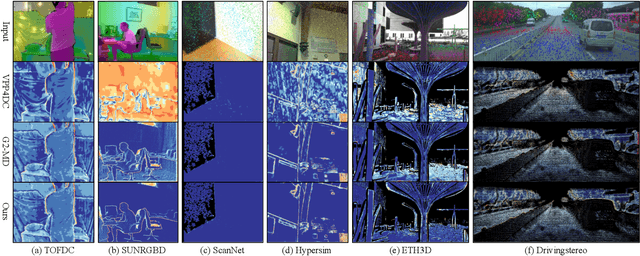

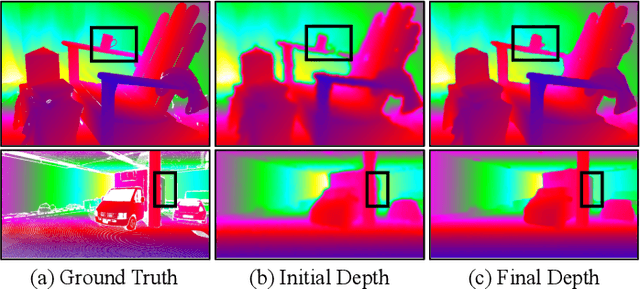

Abstract:Depth completion is a pivotal challenge in computer vision, aiming at reconstructing the dense depth map from a sparse one, typically with a paired RGB image. Existing learning based models rely on carefully prepared but limited data, leading to significant performance degradation in out-of-distribution (OOD) scenarios. Recent foundation models have demonstrated exceptional robustness in monocular depth estimation through large-scale training, and using such models to enhance the robustness of depth completion models is a promising solution. In this work, we propose a novel depth completion framework that leverages depth foundation models to attain remarkable robustness without large-scale training. Specifically, we leverage a depth foundation model to extract environmental cues, including structural and semantic context, from RGB images to guide the propagation of sparse depth information into missing regions. We further design a dual-space propagation approach, without any learnable parameters, to effectively propagates sparse depth in both 3D and 2D spaces to maintain geometric structure and local consistency. To refine the intricate structure, we introduce a learnable correction module to progressively adjust the depth prediction towards the real depth. We train our model on the NYUv2 and KITTI datasets as in-distribution datasets and extensively evaluate the framework on 16 other datasets. Our framework performs remarkably well in the OOD scenarios and outperforms existing state-of-the-art depth completion methods. Our models are released in https://github.com/shenglunch/PSD.
3DAxisPrompt: Promoting the 3D Grounding and Reasoning in GPT-4o
Mar 17, 2025Abstract:Multimodal Large Language Models (MLLMs) exhibit impressive capabilities across a variety of tasks, especially when equipped with carefully designed visual prompts. However, existing studies primarily focus on logical reasoning and visual understanding, while the capability of MLLMs to operate effectively in 3D vision remains an ongoing area of exploration. In this paper, we introduce a novel visual prompting method, called 3DAxisPrompt, to elicit the 3D understanding capabilities of MLLMs in real-world scenes. More specifically, our method leverages the 3D coordinate axis and masks generated from the Segment Anything Model (SAM) to provide explicit geometric priors to MLLMs and then extend their impressive 2D grounding and reasoning ability to real-world 3D scenarios. Besides, we first provide a thorough investigation of the potential visual prompting formats and conclude our findings to reveal the potential and limits of 3D understanding capabilities in GPT-4o, as a representative of MLLMs. Finally, we build evaluation environments with four datasets, i.e., ScanRefer, ScanNet, FMB, and nuScene datasets, covering various 3D tasks. Based on this, we conduct extensive quantitative and qualitative experiments, which demonstrate the effectiveness of the proposed method. Overall, our study reveals that MLLMs, with the help of 3DAxisPrompt, can effectively perceive an object's 3D position in real-world scenarios. Nevertheless, a single prompt engineering approach does not consistently achieve the best outcomes for all 3D tasks. This study highlights the feasibility of leveraging MLLMs for 3D vision grounding/reasoning with prompt engineering techniques.
Commenting Higher-level Code Unit: Full Code, Reduced Code, or Hierarchical Code Summarization
Mar 13, 2025Abstract:Commenting code is a crucial activity in software development, as it aids in facilitating future maintenance and updates. To enhance the efficiency of writing comments and reduce developers' workload, researchers has proposed various automated code summarization (ACS) techniques to automatically generate comments/summaries for given code units. However, these ACS techniques primarily focus on generating summaries for code units at the method level. There is a significant lack of research on summarizing higher-level code units, such as file-level and module-level code units, despite the fact that summaries of these higher-level code units are highly useful for quickly gaining a macro-level understanding of software components and architecture. To fill this gap, in this paper, we conduct a systematic study on how to use LLMs for commenting higher-level code units, including file level and module level. These higher-level units are significantly larger than method-level ones, which poses challenges in handling long code inputs within LLM constraints and maintaining efficiency. To address these issues, we explore various summarization strategies for ACS of higher-level code units, which can be divided into three types: full code summarization, reduced code summarization, and hierarchical code summarization. The experimental results suggest that for summarizing file-level code units, using the full code is the most effective approach, with reduced code serving as a cost-efficient alternative. However, for summarizing module-level code units, hierarchical code summarization becomes the most promising strategy. In addition, inspired by the research on method-level ACS, we also investigate using the LLM as an evaluator to evaluate the quality of summaries of higher-level code units. The experimental results demonstrate that the LLM's evaluation results strongly correlate with human evaluations.
SeisMoLLM: Advancing Seismic Monitoring via Cross-modal Transfer with Pre-trained Large Language Model
Feb 27, 2025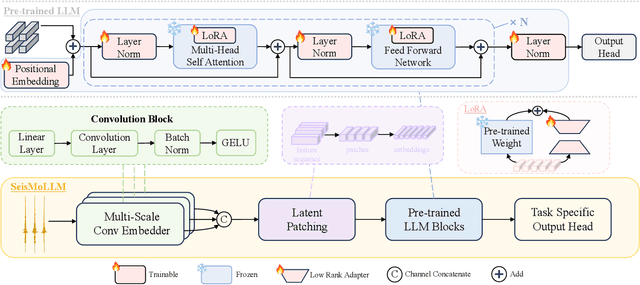
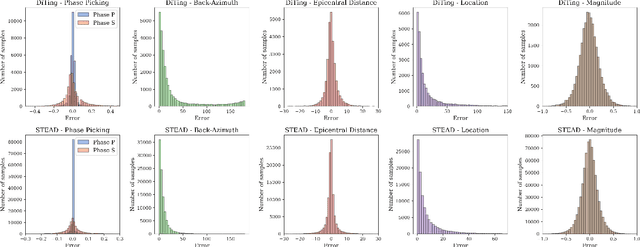
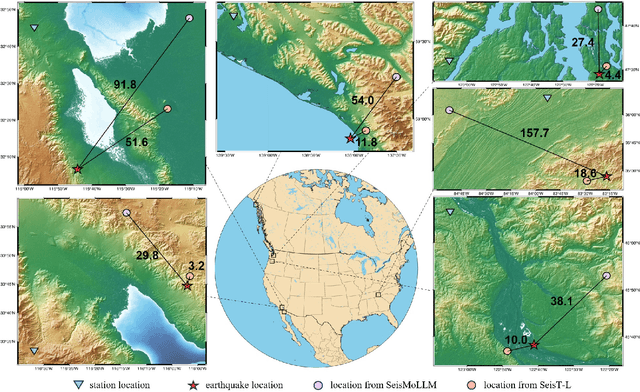
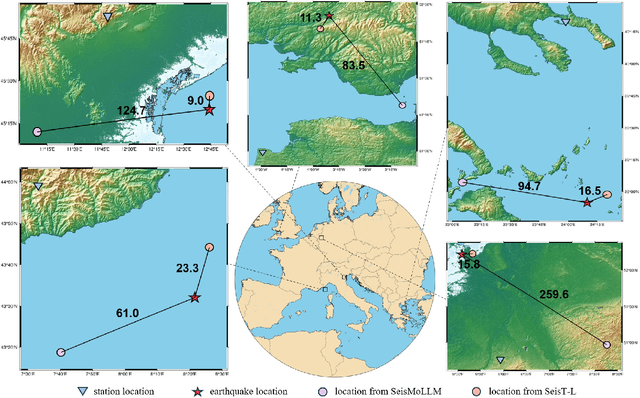
Abstract:Recent advances in deep learning have revolutionized seismic monitoring, yet developing a foundation model that performs well across multiple complex tasks remains challenging, particularly when dealing with degraded signals or data scarcity. This work presents SeisMoLLM, the first foundation model that utilizes cross-modal transfer for seismic monitoring, to unleash the power of large-scale pre-training from a large language model without requiring direct pre-training on seismic datasets. Through elaborate waveform tokenization and fine-tuning of pre-trained GPT-2 model, SeisMoLLM achieves state-of-the-art performance on the DiTing and STEAD datasets across five critical tasks: back-azimuth estimation, epicentral distance estimation, magnitude estimation, phase picking, and first-motion polarity classification. It attains 36 best results out of 43 task metrics and 12 top scores out of 16 few-shot generalization metrics, with many relative improvements ranging from 10% to 50%. In addition to its superior performance, SeisMoLLM maintains efficiency comparable to or even better than lightweight models in both training and inference. These findings establish SeisMoLLM as a promising foundation model for practical seismic monitoring and highlight cross-modal transfer as an exciting new direction for earthquake studies, showcasing the potential of advanced deep learning techniques to propel seismology research forward.
Towards Efficient and Intelligent Laser Weeding: Method and Dataset for Weed Stem Detection
Feb 10, 2025



Abstract:Weed control is a critical challenge in modern agriculture, as weeds compete with crops for essential nutrient resources, significantly reducing crop yield and quality. Traditional weed control methods, including chemical and mechanical approaches, have real-life limitations such as associated environmental impact and efficiency. An emerging yet effective approach is laser weeding, which uses a laser beam as the stem cutter. Although there have been studies that use deep learning in weed recognition, its application in intelligent laser weeding still requires a comprehensive understanding. Thus, this study represents the first empirical investigation of weed recognition for laser weeding. To increase the efficiency of laser beam cut and avoid damaging the crops of interest, the laser beam shall be directly aimed at the weed root. Yet, weed stem detection remains an under-explored problem. We integrate the detection of crop and weed with the localization of weed stem into one end-to-end system. To train and validate the proposed system in a real-life scenario, we curate and construct a high-quality weed stem detection dataset with human annotations. The dataset consists of 7,161 high-resolution pictures collected in the field with annotations of 11,151 instances of weed. Experimental results show that the proposed system improves weeding accuracy by 6.7% and reduces energy cost by 32.3% compared to existing weed recognition systems.
B-VLLM: A Vision Large Language Model with Balanced Spatio-Temporal Tokens
Dec 13, 2024



Abstract:Recently, Vision Large Language Models (VLLMs) integrated with vision encoders have shown promising performance in vision understanding. The key of VLLMs is to encode visual content into sequences of visual tokens, enabling VLLMs to simultaneously process both visual and textual content. However, understanding videos, especially long videos, remain a challenge to VLLMs as the number of visual tokens grows rapidly when encoding videos, resulting in the risk of exceeding the context window of VLLMs and introducing heavy computation burden. To restrict the number of visual tokens, existing VLLMs either: (1) uniformly downsample videos into a fixed number of frames or (2) reducing the number of visual tokens encoded from each frame. We argue the former solution neglects the rich temporal cue in videos and the later overlooks the spatial details in each frame. In this work, we present Balanced-VLLM (B-VLLM): a novel VLLM framework that aims to effectively leverage task relevant spatio-temporal cues while restricting the number of visual tokens under the VLLM context window length. At the core of our method, we devise a text-conditioned adaptive frame selection module to identify frames relevant to the visual understanding task. The selected frames are then de-duplicated using a temporal frame token merging technique. The visual tokens of the selected frames are processed through a spatial token sampling module and an optional spatial token merging strategy to achieve precise control over the token count. Experimental results show that B-VLLM is effective in balancing the number of frames and visual tokens in video understanding, yielding superior performance on various video understanding benchmarks. Our code is available at https://github.com/zhuqiangLu/B-VLLM.
ConsistencyTrack: A Robust Multi-Object Tracker with a Generation Strategy of Consistency Model
Aug 28, 2024



Abstract:Multi-object tracking (MOT) is a critical technology in computer vision, designed to detect multiple targets in video sequences and assign each target a unique ID per frame. Existed MOT methods excel at accurately tracking multiple objects in real-time across various scenarios. However, these methods still face challenges such as poor noise resistance and frequent ID switches. In this research, we propose a novel ConsistencyTrack, joint detection and tracking(JDT) framework that formulates detection and association as a denoising diffusion process on perturbed bounding boxes. This progressive denoising strategy significantly improves the model's noise resistance. During the training phase, paired object boxes within two adjacent frames are diffused from ground-truth boxes to a random distribution, and then the model learns to detect and track by reversing this process. In inference, the model refines randomly generated boxes into detection and tracking results through minimal denoising steps. ConsistencyTrack also introduces an innovative target association strategy to address target occlusion. Experiments on the MOT17 and DanceTrack datasets demonstrate that ConsistencyTrack outperforms other compared methods, especially better than DiffusionTrack in inference speed and other performance metrics. Our code is available at https://github.com/Tankowa/ConsistencyTrack.
PuTR: A Pure Transformer for Decoupled and Online Multi-Object Tracking
May 23, 2024



Abstract:Recent advances in Multi-Object Tracking (MOT) have achieved remarkable success in short-term association within the decoupled tracking-by-detection online paradigm. However, long-term tracking still remains a challenging task. Although graph-based approaches can address this issue by modeling trajectories as a graph in the decoupled manner, their non-online nature poses obstacles for real-time applications. In this paper, we demonstrate that the trajectory graph is a directed acyclic graph, which can be represented by an object sequence arranged by frame and a binary adjacency matrix. It is a coincidence that the binary matrix matches the attention mask in the Transformer, and the object sequence serves exactly as a natural input sequence. Intuitively, we propose that a pure Transformer can naturally unify short- and long-term associations in a decoupled and online manner. Our experiments show that a classic Transformer architecture naturally suits the association problem and achieves a strong baseline compared to existing foundational methods across four datasets: DanceTrack, SportsMOT, MOT17, and MOT20, as well as superior generalizability in domain shift. Moreover, the decoupled property also enables efficient training and inference. This work pioneers a promising Transformer-based approach for the MOT task, and provides code to facilitate further research. https://github.com/chongweiliu/PuTR
Similarity Guided Multimodal Fusion Transformer for Semantic Location Prediction in Social Media
May 09, 2024Abstract:The purpose of semantic location prediction is to extract relevant semantic location information from multimodal social media posts, offering a more contextual understanding of daily activities compared to GPS coordinates. However, this task becomes challenging due to the presence of noise and irrelevant information in "text-image" pairs. Existing methods suffer from insufficient feature representations and fail to consider the comprehensive integration of similarity at different granularities, making it difficult to filter out noise and irrelevant information. To address these challenges, we propose a Similarity-Guided Multimodal Fusion Transformer (SG-MFT) for predicting social users' semantic locations. First, we utilize a pre-trained large-scale vision-language model to extract high-quality feature representations from social media posts. Then, we introduce a Similarity-Guided Interaction Module (SIM) to alleviate modality heterogeneity and noise interference by incorporating coarse-grained and fine-grained similarity guidance for modality interactions. Specifically, we propose a novel similarity-aware feature interpolation attention mechanism at the coarse level, leveraging modality-wise similarity to mitigate heterogeneity and reduce noise within each modality. Meanwhile, we employ a similarity-aware feed-forward block at the fine level, utilizing element-wise similarity to further mitigate the impact of modality heterogeneity. Building upon pre-processed features with minimal noise and modal interference, we propose a Similarity-aware Feature Fusion Module (SFM) to fuse two modalities with cross-attention mechanism. Comprehensive experimental results demonstrate the superior performance of our proposed method in handling modality imbalance while maintaining efficient fusion effectiveness.
ConsistencyDet: A Robust Object Detector with a Denoising Paradigm of Consistency Model
Apr 17, 2024



Abstract:Object detection, a quintessential task in the realm of perceptual computing, can be tackled using a generative methodology. In the present study, we introduce a novel framework designed to articulate object detection as a denoising diffusion process, which operates on the perturbed bounding boxes of annotated entities. This framework, termed ConsistencyDet, leverages an innovative denoising concept known as the Consistency Model. The hallmark of this model is its self-consistency feature, which empowers the model to map distorted information from any temporal stage back to its pristine state, thereby realizing a "one-step denoising" mechanism. Such an attribute markedly elevates the operational efficiency of the model, setting it apart from the conventional Diffusion Model. Throughout the training phase, ConsistencyDet initiates the diffusion sequence with noise-infused boxes derived from the ground-truth annotations and conditions the model to perform the denoising task. Subsequently, in the inference stage, the model employs a denoising sampling strategy that commences with bounding boxes randomly sampled from a normal distribution. Through iterative refinement, the model transforms an assortment of arbitrarily generated boxes into definitive detections. Comprehensive evaluations employing standard benchmarks, such as MS-COCO and LVIS, corroborate that ConsistencyDet surpasses other leading-edge detectors in performance metrics. Our code is available at https://github.com/Tankowa/ConsistencyDet.
 Add to Chrome
Add to Chrome Add to Firefox
Add to Firefox Add to Edge
Add to Edge